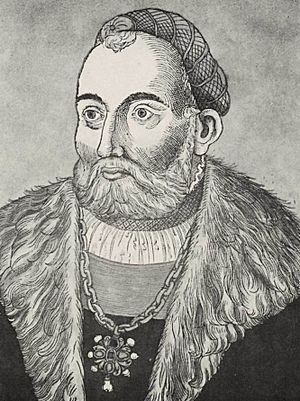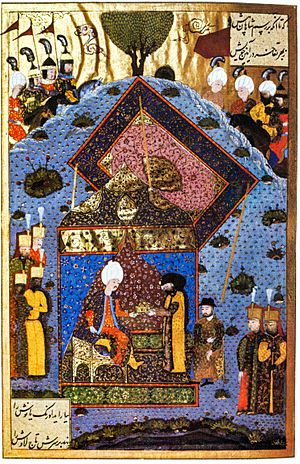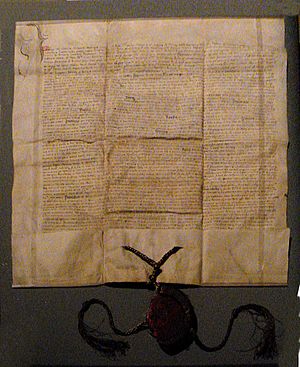John Zápolya facts for kids
Quick facts for kids John I |
|
|---|---|

Engraving by Erhard Schön
|
|
| King of Hungary and Croatia Contested by Ferdinand I |
|
| Reign | 1526–1540 |
| Coronation | 11 November 1526 |
| Predecessor | Louis II |
| Successor | Ferdinand I John II Sigismund Zápolya |
| Born | 1490/91 Szepesváralja, Kingdom of Hungary (now Spišské Podhradie, Slovakia) |
| Died | 22 July 1540 (aged 49–50) Szászsebes, Kingdom of Hungary (now Sebeș, Romania) |
| Burial | Székesfehérvár Basilica |
| Spouse | Isabella Jagiellon |
| Issue | John II Sigismund Zápolya |
| House | House of Zápolya |
| Father | Stephen Zápolya |
| Mother | Hedwig of Cieszyn |
| Signature |  |
John Zápolya (also known as John I of Hungary) was a powerful leader who became King of Hungary from 1526 to 1540. However, his rule was challenged by another ruler, Ferdinand I, who also wanted to be king. Before becoming king, John was the Voivode of Transylvania, a very important position, from 1510 to 1526. He was born around 1490 or 1491 and passed away on July 22, 1540.
Contents
The Zápolya Family's Rise to Power
John was the oldest son of Count Stephen Zápolya and his second wife, Hedwig of Cieszyn. The Zápolya family came from a noble Croatian family in a region called Slavonia. Their name "Zápolya" means "behind the field" in Croatian.
Stephen Zápolya became one of the richest lords in the Kingdom of Hungary. This happened after he inherited a lot of land from his brother, Emeric Zápolya, in 1487. Stephen's marriage to Hedwig, a duchess from Silesia, made the family even more respected. Hedwig was even related to Emperor Maximilian I.
Early Life and Family Connections
When Matthias Corvinus, the King of Hungary, died in 1490, Stephen Zápolya did not have any sons yet. But by September 1491, records show that John had been born. This means John was born sometime between these two dates. Stephen Zápolya became the Palatine of Hungary (a high-ranking official) from 1492 until he died in 1499.
Emperor Maximilian I declared war on Hungary in September 1490. He wanted to protect his claim to become the next king after Vladislaus, which was agreed upon in the 1491 Peace of Pressburg. John's father, Stephen Zápolya, was made one of the commanders of the Hungarian army during this war. In 1506, a secret agreement was made for Vladislaus's daughter, Anne Jagiellon, to marry Maximilian's grandson, Ferdinand.
John's Childhood and Education
John was born in Spiš Castle (now in Slovakia), which was a main center for the Zápolya family's lands. In 1497, some people who opposed Stephen Zápolya spread rumors that he wanted his son, John, to become king.
When their father died in 1499, John and his younger brother, George, inherited huge amounts of land. Most of their lands were in what is now Slovakia. John could write letters in Latin, which shows he received an excellent education from his mother. His mother, Hedwig, wanted King Vladislaus II to marry his only child, Anne, to John. However, the king did not agree to this marriage.
A Leader for the Nobles
John started his public career in 1505 as a member of the Hungarian Parliament, called the Diet, in Rákos. John Zápolya suggested a new law that was passed on October 13, 1505. This law said that if King Vladislaus died without a son, no foreigner could be elected king. John hoped this law would help him become king after Vladislaus. However, the king refused to approve the law and closed the Diet. Also, King Vladislaus's wife had a son, Louis, in 1506, which changed things.
John's disagreements with the royal court made him the leader of a "national party." This group was made up of smaller noblemen (called the gentry) who did not like the idea of the Habsburg family ruling Hungary. The higher nobles, church leaders, and King Vladislaus usually supported the Habsburgs. Even though the Diet at first didn't want to accept young Prince Louis as the next king, he was finally crowned in 1508 because Vladislaus insisted.
Voivode of Transylvania
On November 8, 1510, King Vladislaus II made John Zápolya the Voivode of Transylvania and Count of the Székelys. These were very important positions. John moved to Transylvania in March 1511.
The Ottomans started attacking the southern border of Hungary in April 1511. John often held meetings for the leaders of the "Three Nations of Transylvania" (groups of people living there). He also led the courts for the Székely people.
In early 1512, John's younger sister, Barbara Zápolya, married the Polish king, Sigismund I the Old. This made the Zápolya family even more powerful for a short time, but Barbara died in 1515. John showed off his family's wealth by traveling with Barbara to Poland with 800 horsemen wearing fancy clothes.
In the summer of 1513, John led a military raid into Ottoman Bulgaria. When he returned to Transylvania, he stopped a revolt in Hermanstadt (now Sibiu, Romania) and made the townspeople pay an extra tax.
The Peasant Revolt
In 1514, Tamás Bakócz, a high church leader, called for a crusade (a holy war) against the Ottomans. About 40,000 peasants joined this crusade and gathered near Pest. Their lords tried to stop them before the harvest, but they left anyway.
John started another military campaign in Bulgaria in early May. An army of armed peasants also left Pest to fight the Ottoman Empire. However, as they marched, they started robbing the nearby homes of nobles. Many villagers refused to pay their taxes. The king and the church leader ordered the peasants to go home, but they refused. Their groups took control of the southern lowlands along the Danube and Tisza rivers and killed many nobles.
The main peasant army, led by György Dózsa, attacked Temesvár (now Timișoara, Romania). Stephen Báthory defended the town. John Zápolya, who had returned from his Ottoman campaign, came to help Temesvár. His army defeated the peasants on July 15.
After the revolt, the Diet (Parliament) took away the peasants' right to move freely. They also made peasants work on their lords' lands for free one day each week. The Diet praised John Zápolya as the "liberator of the realm" and gave him a reward. Most of John's supporters were chosen for the royal council.
In 1515, Zápolya and other leaders tried to capture an Ottoman fortress near Nándorfehérvár (now Belgrade, Serbia). But their combined troops were defeated by the Ottoman commander Sinan. This defeat made John's position weaker.
King of Hungary
In 1526, the Ottoman Empire defeated the Hungarian army in the Battle of Mohács. King Louis II was killed in this battle. John Zápolya was on his way to the battle with his large army but did not take part for reasons that are not fully known. The Ottomans then took over the capital city of Buda and other areas, but later they left Hungary. For three months, there was no clear ruler in Hungary.
Two main leaders came forward to claim the throne. One was John Zápolya, who was the Voivode of Transylvania and the most important noble in Hungary. He also had a strong army. The other was Archduke Ferdinand of Austria. He was the late king's brother-in-law and the brother of Emperor Charles V. Ferdinand believed he had a right to the Hungarian throne.
Most of Hungary's smaller nobles (the gentry) supported John Zápolya. He had been a key figure in Hungarian politics for 15 years. Some of the higher nobles also supported him. Many of his opponents had died at the Battle of Mohács, and the royal family of Hungary no longer had a direct heir.
The higher nobles of Hungary (called magnates or barons) sided with Ferdinand. They gathered in Pozsony (now Bratislava) for Ferdinand's election. They argued that the Habsburg family (Ferdinand's family) could help Hungary fight against the Ottomans. However, in 1526, this promise didn't seem very strong. Hungary had been fighting the Ottomans for over a century, and the Habsburgs had not given much real help. Also, Ferdinand's older brother, Emperor Charles V, was fighting a war with France, which made it even less likely that Ferdinand could help Hungary.
John Zápolya did not pay attention to Ferdinand's claims. On November 10, 1526, John was declared king by the gentry at a Diet in Székesfehérvár. He was crowned the next day. Ferdinand was also elected king by the higher nobles and church leaders in Pozsony on December 17, 1526.
John tried to bring back order to the country. He used his own great wealth and the strong support of the smaller nobles to carry out his plans. However, he struggled to get support from other countries. He tried to make an alliance with the Habsburgs against the Ottomans, but Ferdinand refused. John sent messengers across Europe to find support, but only France showed interest. However, France wanted Hungary to join a war against the Habsburgs, not to make peace.
In 1527, the political situation in Europe changed. The Emperor's army took over Rome, forcing the Pope, who was an ally of France, to surrender. This freed Ferdinand to focus on Hungary. Ferdinand believed that if Hungary couldn't fight the Ottomans on its own, it might join forces with them against Austria and Bohemia. So, it was important for the Habsburgs to control Hungary, even if it meant using force.
In July 1527, Ferdinand sent an army of German soldiers into Hungary. This was a good time for him because John Zápolya's forces were busy in the southern parts of Hungary. Slavonic peasants, encouraged by Ferdinand, had rebelled, led by a person known as the 'Black Man', Jovan Nenad. The pro-Habsburg soldiers quickly captured Buda. John quickly moved his army, but on September 27, he suffered a big defeat in the Battle of Tarcal. Based on the earlier election, Ferdinand was crowned in the Székesfehérvár Basilica on November 3, 1527.
In 1528, John fled Hungary to Poland. In 1529, John asked the Ottomans for help. He agreed to make Hungary a vassal state (meaning it would be under Ottoman control) in return for their support. Suleiman the Magnificent, the Ottoman Sultan, agreed. He sent Ottoman armies to attack Austria, which included the Siege of Vienna. This war lasted until 1533. This allowed John to regain his position in Hungary in 1529, thanks to the efforts of Frater George Martinuzzi. Martinuzzi became John's most trusted minister.
In 1533, the Ottomans made peace and gave western Hungary to Ferdinand. Ferdinand then started to pressure John to give up the rest of Hungary. In 1538, John signed the Treaty of Nagyvárad, agreeing that Ferdinand would become king after John died, as John had no children at that time. However, in early 1539, John married Isabella Jagiellon. On July 15, 1540, they had a son, John Sigismund. King John died just seven days later, on July 22, 1540, in Szászsebes (now Sebeș, Romania).
See also
 In Spanish: Juan I de Zápolya para niños
In Spanish: Juan I de Zápolya para niños
- Beatrice of Naples
- First Congress of Vienna
- Ivan Karlović
- Petar Keglević
Sources
|
János I Szapolyai
House of Szapolyai
Born: 2 February 1487 Died: 22 July 1540 |
||
| Regnal titles | ||
|---|---|---|
| Preceded by Péter Szentgyörgyi |
Voivode of Transylvania 1510–1526 |
Succeeded by Péter Perényi |
| Preceded by Louis II |
King of Hungary contested by Ferdinand I 1526–1540 |
Succeeded by John II Sigismund |




